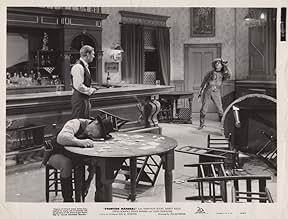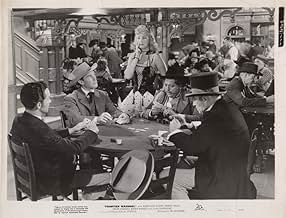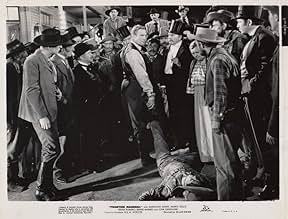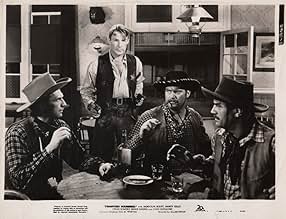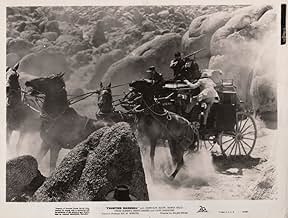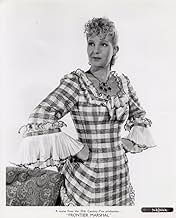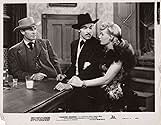NOTE IMDb
6,6/10
1,1 k
MA NOTE
Wyatt Earp accepte le poste de shérif afin de rétablir l'ordre à Tombstone.Wyatt Earp accepte le poste de shérif afin de rétablir l'ordre à Tombstone.Wyatt Earp accepte le poste de shérif afin de rétablir l'ordre à Tombstone.
- Réalisation
- Scénario
- Casting principal
- Récompenses
- 1 victoire au total
Dell Henderson
- Dave Hall
- (as Del Henderson)
Eddie Dunn
- Card Player
- (scènes coupées)
Avis à la une
1939's "Frontier Marshal" was the clear inspiration for John Ford's 1946 "My Darling Clementine," but was actually the second screen version of Wyatt Earp's posthumous tome, a highly fictionalized account of his Wild West days. In the wake of Fox's successful "Jesse James," it's no surprise that they would perform similar heroism toward other notorious figures, with handsome Randolph Scott enjoying one of his earliest lead roles as Wyatt Earp, and heartthrob Cesar Romero in the highly romanticized part of Doc Halliday. The villains are certainly an interesting lot, with John Carradine, Lon Chaney, and Joseph Sawyer among them, they're just totally ineffective against Earp, for whom everything falls into place too easily. Carradine's Ben Carter runs a saloon across the street from the one that does more business (where the broads hang out), so he and his gang resort to occasional holdups to keep things interesting. Carradine actually gets the least amount of screen time, while Lon Chaney's Pringle at least gets to 'dance' before the trigger happy Halliday. By the time we get to the OK Corral, only Sawyer's Curly Bill remains standing to take the fall, Chaney and Carradine casually dismissed in ignominious fashion. The two actors, already teamed as James gang members in "Jesse James," both went on to greater glory by year's end, Carradine in "The Grapes of Wrath," Chaney in "Of Mice and Men." Chaney would reappear opposite Randolph Scott in 1944's "Follow the Boys" and 1947's "Albuquerque," while Carradine appeared with Scott in 1941's "Western Union" and 1945's "Captain Kidd." In addition, Carradine would oppose Wyatt Earp twice more, opposite Hugh O'Brian in the 1959 TV episode "The Fugitive," and opposite James Stewart in 1964's "Cheyenne Autumn." The only character that really resonates is Romero's Halliday, here a surgeon rather than dentist, while Ward Bond (playing the cowardly former Tombstone marshal) not only appears from the 1934 version, but graduated to Morgan Earp in the John Ford remake. It's a solid and enjoyable Western, but below the standard set that year by "Stagecoach" or "Destry Rides Again."
That would describe Wyatt Earp. Lucky because I can't think of anyone else who's had more stalwart Hollywood heroes playing him in film. Off the top of my head Tom Mix, George O'Brien, Henry Fonda, Burt Lancaster, James Garner, James Stewart, Joel McCrea right down to Kurt Russell and Kevin Costner. We certainly can't forget Hugh O'Brian on television. And also Wyatt was lucky in that he lived long enough so that no one was around to refute him when he gave a series of interviews to Stuart Lake for an authorized biography shortly before he died in 1929.
As this film is based on Lake's book you won't get anything else but the Wyatt of legend. Certainly Randolph Scott fulfills the legend and that's what we print according to John Ford.
This film isn't too often seen because whole parts of it were taken and used by John Ford in My Darling Clementine. Frontier Marshal should be seen back to back to graphically illustrate the difference between a good routine action western and an almost poetical film expression.
Parts that were played by Victor Mature, Cathy Downs, and Linda Darnell in My Darling Clementine are taken here by Cesar Romero, Nancy Kelly, and Binnie Barnes. It might seem odd that British Binnie Barnes would show up in a western as a saloon girl, but that's no more strange than Marlene Dietrich doing the same that year and being very accepted.
Eddie Foy, Jr. is in the cast playing his celebrated father who was entertaining in Tombstone at the time the Earps were providing law and order.
The Clantons believe it or not are completely eliminated from the story. The chief villain is real life Clanton retainer Curly Bill Brocius played here by Joe Sawyer. Eliminated also are Wyatt's brothers and as you can imagine the final shootout at the OK Corral is staged differently than in any other telling of the tale.
Probably Randolph Scott's Wyatt Earp would be a lot better known had he the benefit of John Ford's direction.
As this film is based on Lake's book you won't get anything else but the Wyatt of legend. Certainly Randolph Scott fulfills the legend and that's what we print according to John Ford.
This film isn't too often seen because whole parts of it were taken and used by John Ford in My Darling Clementine. Frontier Marshal should be seen back to back to graphically illustrate the difference between a good routine action western and an almost poetical film expression.
Parts that were played by Victor Mature, Cathy Downs, and Linda Darnell in My Darling Clementine are taken here by Cesar Romero, Nancy Kelly, and Binnie Barnes. It might seem odd that British Binnie Barnes would show up in a western as a saloon girl, but that's no more strange than Marlene Dietrich doing the same that year and being very accepted.
Eddie Foy, Jr. is in the cast playing his celebrated father who was entertaining in Tombstone at the time the Earps were providing law and order.
The Clantons believe it or not are completely eliminated from the story. The chief villain is real life Clanton retainer Curly Bill Brocius played here by Joe Sawyer. Eliminated also are Wyatt's brothers and as you can imagine the final shootout at the OK Corral is staged differently than in any other telling of the tale.
Probably Randolph Scott's Wyatt Earp would be a lot better known had he the benefit of John Ford's direction.
This was the movie which John Ford remade as his classic My Darling Clementine. Here, Randolph Scott plays Wyatt Earp and Caesar Romero plays Doc Holiday, but there are no Clantons or Earp brothers. Instead, John Carradine plays a bad saloon owner heading a gang that is trying to take over Tombstone.
Of course, this movie can't directly compare to My Darling Clementine, but it's a pretty good western in its own right. Its one of Randolph Scott's better early roles.
Many of the classic scenes in My Darling Clementine were taken directly from this movie, and it's very interesting to compare the two. This version of Frontier Marshal was a remake of an earlier 1933 version, and, of course, this story has been told many times since.
The Maltin Guide gives it three stars. Check it out if you're a western fan, or just a fan of My Darling Clementine.
Of course, this movie can't directly compare to My Darling Clementine, but it's a pretty good western in its own right. Its one of Randolph Scott's better early roles.
Many of the classic scenes in My Darling Clementine were taken directly from this movie, and it's very interesting to compare the two. This version of Frontier Marshal was a remake of an earlier 1933 version, and, of course, this story has been told many times since.
The Maltin Guide gives it three stars. Check it out if you're a western fan, or just a fan of My Darling Clementine.
Yes, yes, I know. My Darling Clementine(MDC) is a famous remake of this picture. That one got the John Ford treatment and went into greater depth as far as character development goes. But there's nothing wrong with "Frontier Marshal" and it can stand on its own. First off, since it is an action western it had a better lead actor in stalwart Randolph Scott - Henry Fonda was a more cerebral actor and not really a two-fisted type. Second, I think Caesar Romero played Doc Holliday with more heart than Victor Mature, who was a limited actor.
In MDC, the OK Corral confrontation was better and had more tension but the barroom bimbo was Binnie Barnes, who did a better job than Linda Darnell. Ward Bond was in both pictures and got a promotion in MDC to Earp's brother. And you get a chance to see Eddie Foy Jr. in the earlier movie.
"Frontier Marshal" is only 71" long and therefore not as comprehensive as MDC. In sum, I guess the worst thing that could be said about "Frontier Marshal" is that MDC was made, which in sheer production value diminishes the whole enterprise. If you like westerns, see this one. You will appreciate it better if you haven't seen MDC - which I also feel suffers from one of the lamest titles in Hollywood annals and detracts from the final product. "Frontier Marshal" was on FMC the other morning and I rated it a seven.
In MDC, the OK Corral confrontation was better and had more tension but the barroom bimbo was Binnie Barnes, who did a better job than Linda Darnell. Ward Bond was in both pictures and got a promotion in MDC to Earp's brother. And you get a chance to see Eddie Foy Jr. in the earlier movie.
"Frontier Marshal" is only 71" long and therefore not as comprehensive as MDC. In sum, I guess the worst thing that could be said about "Frontier Marshal" is that MDC was made, which in sheer production value diminishes the whole enterprise. If you like westerns, see this one. You will appreciate it better if you haven't seen MDC - which I also feel suffers from one of the lamest titles in Hollywood annals and detracts from the final product. "Frontier Marshal" was on FMC the other morning and I rated it a seven.
For seventy-one minutes the film manages to fit in the deteriorating security situation in Tombstone as the camera flashes to the street for all the shootouts and horseplay. Compared to My Darling Clementine, this one is more easy going. Cesar Romero captures best acting over Vic Mature in the role of Doc Holliday, IMHO if only because Mature's part seemed overwrought, and the part of Holliday seems to fit Romero in a decisively more real way. Even still, the script in Frontier Marshal still caricatures Holliday as overly emotional, especially in the scenes in the saloon where he's purposely drinking himself to death because ex-flame Nancy Kelly comes in on the stage. Still, Romero was a great actor, and his scenes with Randolph Scott as Earp are a nice mix of two actors who had real naturalness. The B&W photography (Charles Clarke) stands out throughout and all the scenes in this movie are well assembled. It is over before you know it.
Le saviez-vous
- AnecdotesCharles Stevens, who plays a drunken Indian, repeats the role in director John Ford's remake, La poursuite infernale (1946). Stevens, who was half Mexican and half Apache, was the grandson of legendary Apache warrior Geronimo.
- GaffesThe film has Doc Holliday being shot to death in an ambush by Curly Bill Brocius shortly before the shootout at the O.K. Corral in Tombstone, Arizona, on October 26. 1881. In reality, Holliday died of consumption in Glenwood Springs, Colorado, on November 8, 1887.
- Citations
Sarah Allen: John...
John 'Doc' Halliday: Yes, Sarah?
Sarah Allen: Isn't it more thrilling to give life than take it away?
- ConnexionsFeatured in Fejezetek a film történetéböl: Amerikai filmtípusok - A western (1989)
- Bandes originalesRock-a-Bye Baby
(1886) (uncredited)
Music and Lyrics by Effie I. Canning
Sung by Margaret Brayton a cappella
Meilleurs choix
Connectez-vous pour évaluer et suivre la liste de favoris afin de recevoir des recommandations personnalisées
- How long is Frontier Marshal?Alimenté par Alexa
Détails
- Durée1 heure 11 minutes
- Couleur
- Rapport de forme
- 1.37 : 1
Contribuer à cette page
Suggérer une modification ou ajouter du contenu manquant

Lacune principale
By what name was L'Aigle des frontières (1939) officially released in India in English?
Répondre
